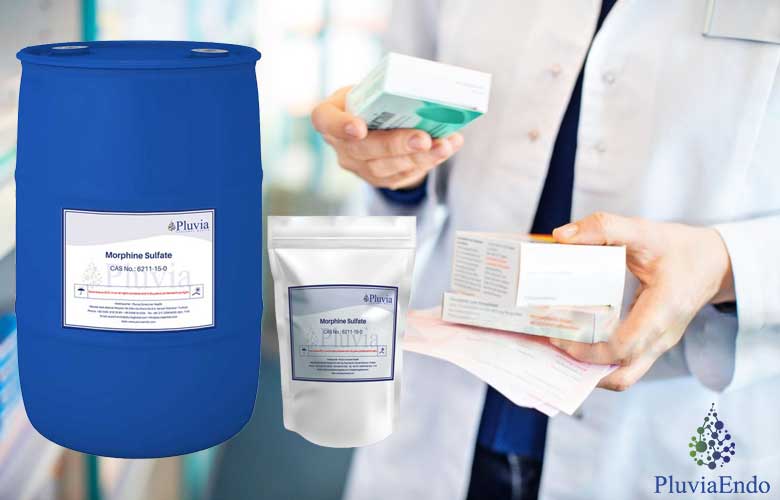Morphine, a potent opioid analgesic, plays a crucial role in managing severe pain when other treatments are inadequate. However, Morphine prescription requires careful consideration of various factors to optimize patient outcomes while minimizing risks. In this blog post, we will explore key considerations for healthcare professionals when prescribing morphine.
As a leading pharmaceutical manufacturer of Morphine Sulfate API, Pluvia Endo is committed to providing healthcare professionals with the resources and support needed. We aim to ensure the safe and effective use of this vital pain medication.
Assessing Patient Suitability for Morphine Prescription
Before initiating a morphine prescription, it is essential to evaluate the patient’s medical history and current condition thoroughly. Healthcare providers should consider the following:
- Severity of Pain: Morphine is typically reserved for severe pain that other analgesics or non-pharmacological interventions cannot adequately manage.
- Underlying Conditions: Comorbidities such as respiratory disorders, renal or hepatic impairment, and mental health issues may impact the safety and efficacy of morphine therapy.
- Risk of Abuse or Addiction: Patients with a personal or family history of substance use disorder may be at higher risk of developing opioid dependence and should be closely monitored.
- Concurrent Medications: Interactions with other drugs, particularly benzodiazepines and sedatives, can increase the risk of respiratory depression and should be carefully evaluated.
Selecting Morphine Prescription Formulation
Morphine is available in various formulations, each with its advantages and considerations:
- Immediate-Release (IR) Tablets: IR morphine provides rapid pain relief but requires more frequent dosing. It is often used for acute or breakthrough pain in chronic patients.
- Extended-Release (ER) Tablets: ER morphine offers continuous pain control with less frequent dosing, which can improve adherence and quality of life. However, it is not suitable for acute pain management.
- Oral Solutions: Healthcare providers may prefer liquid formulations for patients who have difficulty swallowing tablets or capsules, such as the elderly or those with dysphagia.
- Injectable Solutions: Healthcare providers typically reserve parenteral morphine for patients experiencing severe acute pain in hospital settings or for those who cannot tolerate oral administration.
Healthcare providers should consider the patient’s individual needs and preferences when selecting the appropriate morphine formulation. They should also consider the patient’s ability to adhere to the prescribed regimen.
Determining the Optimal Morphine Prescription Dosage
Healthcare providers must individualize morphine dosing based on the patient’s pain severity, treatment response, and risk factors. The goal is to find the lowest effective dose that provides adequate pain relief while minimizing adverse effects. Healthcare providers should:
- Start Low and Go Slow: Begin with the lowest possible effective dose and titrate gradually based on the patient’s response.
- Avoid Abrupt Discontinuation: Sudden cessation of morphine can lead to withdrawal symptoms. If discontinuing therapy, gradually taper the dose to minimize discomfort.
- Monitor for Adverse Effects: Closely monitor patients for common side effects such as constipation, nausea, drowsiness, and respiratory depression, and manage them proactively.
- Adjust Dosage as Needed: Regularly assess the patient’s pain control and adjust the morphine dose accordingly. Be aware that tolerance may develop over time, necessitating dose increases.
Educating about Morphine Prescription
Patient education is crucial for the safe and effective use of morphine. Healthcare providers should:
- Explain the Risks and Benefits: Discuss the potential risks of opioid therapy, including dependence, addiction, and overdose, as well as the expected benefits of pain relief and improved quality of life.
- Provide Clear Instructions: Ensure patients understand how to take morphine correctly, including the importance of not exceeding the prescribed dose or sharing medication with others.
- Emphasize Safe Storage and Disposal: Advise patients to store morphine securely and dispose of unused medication properly to prevent accidental exposure or misuse by others.
- Encourage Open Communication: Encourage patients to report any adverse effects, changes in pain levels, or concerns about their morphine prescription to their healthcare provider.
Collaborating with Other Providers
Effective pain management often requires a multidisciplinary approach. Healthcare providers should:
- Coordinate Care: Communicate with other providers involved in the patient’s care, such as primary care physicians, specialists, and pharmacists, to ensure a consistent and comprehensive treatment plan.
- Consult Prescription Drug Monitoring Programs (PDMPs): Check PDMPs to identify potential misuse or diversion of controlled substances and to avoid prescribing morphine to patients who may be at risk.
- Consider Referrals: If necessary, refer patients to pain management specialists, addiction treatment providers, or mental health professionals for additional support and care.
Conclusion
Morphine prescription requires a balanced approach. It must consider the benefits of pain relief while mitigating the risks associated with opioid therapy. By following best practices, healthcare providers can optimize patient outcomes and ensure safe access to this essential medication.
We actively support healthcare professionals in providing compassionate and evidence-based pain management. We support the responsible use of morphine and other opioid analgesics.
For more information about our Morphine Sulfate API or to discuss your specific needs, please contact us today.







